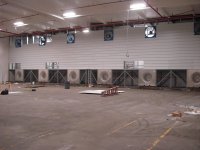jrfraney
Member
I'm new to the forum so first hi all.
Ok I need some help with some fans that I'm trying to sequence. First I'm using a ABB PM573-ETH PLC. Programming with coDeSys.
Basically what we are trying to accomplish is:
1. We have six fans with six switches. That are DI's.
2. When the first fan switch gets flipped it comes on right away.
3. When the second fan gets flipped on it has to wait for x amount of time before it is allowed to turn on.
4. This continues to happen until all are turned on. (they are given sequencing numbers based on the order they are switched on.)
5. These fans need to be able to be turned off and on all day without interruption.
6. Also I have a delay before the fans can get a sequence number because the people in the field flip the switches on and off expecting the fans to turn on. We have told them many times that there is a built in delay. (The delay has to be there for the purposes of the application.)
I have most of the code done but I'm running into issues with it getting out of sequence once the fans are on and I toggle other fans. I have attached a PDF of my code. If there is a more efficient way of doing this please let me know. I'm a self taught programmer and I'm struggling with this. If you need more information I'm glad to give it!
Thanks!!!
Ok I need some help with some fans that I'm trying to sequence. First I'm using a ABB PM573-ETH PLC. Programming with coDeSys.
Basically what we are trying to accomplish is:
1. We have six fans with six switches. That are DI's.
2. When the first fan switch gets flipped it comes on right away.
3. When the second fan gets flipped on it has to wait for x amount of time before it is allowed to turn on.
4. This continues to happen until all are turned on. (they are given sequencing numbers based on the order they are switched on.)
5. These fans need to be able to be turned off and on all day without interruption.
6. Also I have a delay before the fans can get a sequence number because the people in the field flip the switches on and off expecting the fans to turn on. We have told them many times that there is a built in delay. (The delay has to be there for the purposes of the application.)
I have most of the code done but I'm running into issues with it getting out of sequence once the fans are on and I toggle other fans. I have attached a PDF of my code. If there is a more efficient way of doing this please let me know. I'm a self taught programmer and I'm struggling with this. If you need more information I'm glad to give it!
Thanks!!!





